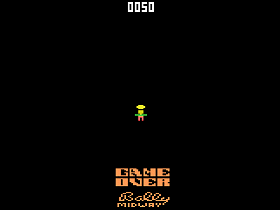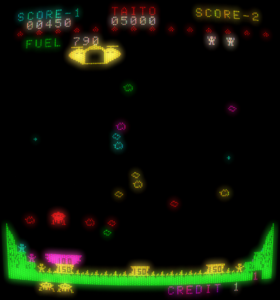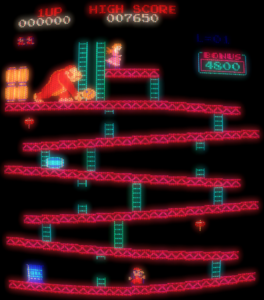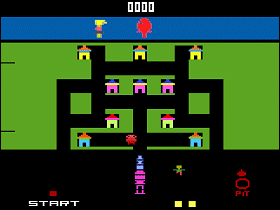 The Game: You are the intrepid, barbershop-quartet-suited J.J., out to save a damsel in distress from a pursuing monster. How does a guy in a little striped suit do this? By building a mobile, tennis-ball-launching contraption to dispatch said dastardly monster, naturally. The catch? The eight pieces of your mechanical creation are hidden somewhere among ten little houses in a maze – and those houses that don’t contain parts of your machine contain a bomb that must be dumped into the bomb pit immediately (else they’ll explode and kill J.J.). Critters also roam the maze to annoy you, including one pesky monster who will prematurely jump on the “start” button, rattling your still-unfinished machine to bits. If you don’t build your Rube Goldberg gizmo in time, the monster catches the damsel and you lose a life. (CBS Electronics, 1983)
The Game: You are the intrepid, barbershop-quartet-suited J.J., out to save a damsel in distress from a pursuing monster. How does a guy in a little striped suit do this? By building a mobile, tennis-ball-launching contraption to dispatch said dastardly monster, naturally. The catch? The eight pieces of your mechanical creation are hidden somewhere among ten little houses in a maze – and those houses that don’t contain parts of your machine contain a bomb that must be dumped into the bomb pit immediately (else they’ll explode and kill J.J.). Critters also roam the maze to annoy you, including one pesky monster who will prematurely jump on the “start” button, rattling your still-unfinished machine to bits. If you don’t build your Rube Goldberg gizmo in time, the monster catches the damsel and you lose a life. (CBS Electronics, 1983)
Memories: Sometimes arcade translations for the Atari 2600 miss the mark, and sometimes they’re right on the money. Blue Print isn’t necessarily either extreme; it’s close enough for government work.
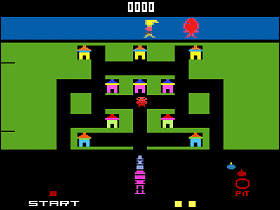 The entire playfield is there, I’ll grant them that; what’s really missing from this game is the ease of control that makes the coin-op look and feel deceptively easy (when it’s anything but). When you’ve got a game with a clock counting down to destruction (or, in Blue Print‘s case, an evil critter who’s chasing J.J.’s girlfriend and closing in with every second), that last thing you need is a problem with the controls. Control of this game isn’t horrible, but it’s not as good as it could be, either.
The entire playfield is there, I’ll grant them that; what’s really missing from this game is the ease of control that makes the coin-op look and feel deceptively easy (when it’s anything but). When you’ve got a game with a clock counting down to destruction (or, in Blue Print‘s case, an evil critter who’s chasing J.J.’s girlfriend and closing in with every second), that last thing you need is a problem with the controls. Control of this game isn’t horrible, but it’s not as good as it could be, either.
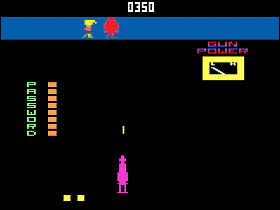
 Some of the coin-op’s finer details, including its catchy music, doesn’t make the jump to the home cartridge (nor would one really expect it to for the 2600 version), but enough that is recognizably Blue Print is there – it’s just a shame that it’s hard to get a handle on it.
Some of the coin-op’s finer details, including its catchy music, doesn’t make the jump to the home cartridge (nor would one really expect it to for the 2600 version), but enough that is recognizably Blue Print is there – it’s just a shame that it’s hard to get a handle on it.
